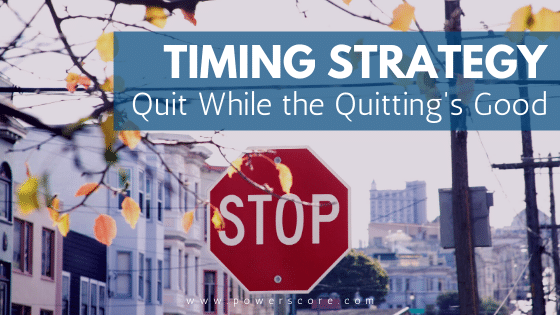Our inspiration for this post comes from an exceptional episode of Freakonomics Radio that counters a prevailing norm that quitting is somehow nearly always bad. The episode, The Upside of Quitting, centers on the efficiency you gain by knowing when to quit. The anti-quitting bias is one that we all tend to carry with us into the LSAT. Just like most real-world experiences we bring to the test, this bias can hurt us. Knowing when to avoid or retreat from a question is a valuable skill that can make a huge difference. It may be the difference between your first-choice school and your second. In today’s application environment, it can be the difference between winning or losing grants or scholarships.
Sunk & Opportunity Costs
Driving the decision concerning whether and when to “quit” can relate to the economic concepts of sunk and opportunity costs. A sunk cost is one already spent, whether it be time, money, or another resource. For example, consider this situation regarding the International Space Station.
In 2011, the Russians announced that the station was simply too costly and complicated to maintain. Their plan was to let it break orbit and crash into the ocean. This plan reportedly “shocked” United States officials, who cited the “input of billions of dollars into the space station.” The United States’ response implies an application of the sunk cost fallacy. The amount of money previously committed to the space station is not by itself evidence that any future resource allocation is appropriate. There may be other reasons that support future spending, but past expenditures alone won’t suffice. The United States’ response implies an application of the sunk cost fallacy. The amount of money previously committed to the space station is not by itself evidence that any future resource allocation is appropriate. There may be other reasons that support future spending, but past expenditures alone won’t suffice.
Regarding opportunity cost, anyone considering spending three years in law school faces the concept. The opportunity cost of going to law school is the money you will not earn while in school, your benefits, your work experience, etc. David Bernstein wrote about this idea last year over at the Volokh Conspiracy.
Adapt Your LSAT Strategy
These concepts apply equally well to your strategy when taking the LSAT. If you find yourself spending a few minutes on an LR stimulus but aren’t making headway on a prephase. Or, if you can’t figure out which answer choice is correct. This is the time where you need to decide whether to continue slugging it out or move on.
It’s common for a person to doggedly persevere when confronted with that decision. Unfortunately, that’s a losing proposition. If it’s taking longer than normal to correctly answer the question the LSAT Casino has likely won this round. Try to appreciate that your chances of guessing the correct answer has gone from 20% to 50% and move on. Don’t waste time throwing “good money after bad” and cut your losses. This is the idea of refusing to be mired in sunk costs on the LSAT.
As to opportunity cost, every second you’re grinding away without results on a difficult question is an irreplaceable second. You’ve lost valuable time you could’ve used on another question. Remember that each correct answer, either simple or difficult, contributes just one point to your raw score. If you continue to belabor on a hard question, it might cause you to run out of time. Who knows, there might have been a question you could dominate right around the corner.
Confidence in Knowledge
As a bonus, there is a psychological advantage to giving yourself permission to move on when the time is right. Don’t let the LSAT push you around or make you a passive victim of its psychometrically manipulated ordering. It’s your test, take control. By test day, know who you are as a test taker; your strengths as well as your weaknesses. Going into the LSAT with a strategy is crucial to your success. Empower yourself by establishing a pecking order of questions that compliment your strengths and avoid your weaknesses. You can read more about approaching each section strategically in this series from Jon Denning.
Ultimately, what’s your true objective? Hopefully, it’s to get the highest raw score possible, not to answer every question in order no matter how long it takes. Learning to quit while the quitting is good will help you keep your sanity and improve your score. It’s your test, take control.


Leave a Reply